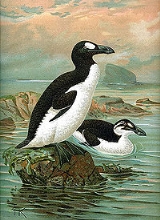
Great Auk
Overview
The Great Auk, Pinguinus impennis, formerly of the genus
Alca
, was a large, flightless alcid that became extinct
in the mid-19th century. It was the only modern species
in the genus Pinguinus, a group of bird
s that formerly included one other species of flightless giant auk
from the Atlantic Ocean
region. It bred on rocky, isolated islands with easy access to both the ocean and a plentiful food supply, a rarity in nature that provided only a few breeding sites for the auks.
Genus
In biology, a genus is a low-level taxonomic rank used in the biological classification of living and fossil organisms, which is an example of definition by genus and differentia...
Alca
Razorbill
The Razorbill is colonial seabird that will only come to land in order to breed. It is the largest living member of the Auk family. This agile bird will choose only one partner for life and females will lay one egg per year. Razorbills will nest along coastal cliffs in enclosed or slightly exposed...
, was a large, flightless alcid that became extinct
Extinction
In biology and ecology, extinction is the end of an organism or of a group of organisms , normally a species. The moment of extinction is generally considered to be the death of the last individual of the species, although the capacity to breed and recover may have been lost before this point...
in the mid-19th century. It was the only modern species
Species
In biology, a species is one of the basic units of biological classification and a taxonomic rank. A species is often defined as a group of organisms capable of interbreeding and producing fertile offspring. While in many cases this definition is adequate, more precise or differing measures are...
in the genus Pinguinus, a group of bird
Bird
Birds are feathered, winged, bipedal, endothermic , egg-laying, vertebrate animals. Around 10,000 living species and 188 families makes them the most speciose class of tetrapod vertebrates. They inhabit ecosystems across the globe, from the Arctic to the Antarctic. Extant birds range in size from...
s that formerly included one other species of flightless giant auk
Auk
An auk is a bird of the family Alcidae in the order Charadriiformes. Auks are superficially similar to penguins due to their black-and-white colours, their upright posture and some of their habits...
from the Atlantic Ocean
Atlantic Ocean
The Atlantic Ocean is the second-largest of the world's oceanic divisions. With a total area of about , it covers approximately 20% of the Earth's surface and about 26% of its water surface area...
region. It bred on rocky, isolated islands with easy access to both the ocean and a plentiful food supply, a rarity in nature that provided only a few breeding sites for the auks.
Unanswered Questions

